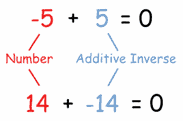
Additive inverses or opposites: Additive identity states that the sum of the number and zero yields the same number.

Irrational Numbers: Any real number that can not be expressed as a fraction.

Measure of Central Tendency: The three most common measures of central tendency are the mean, the median a
and the mode.
Odds: The ratio of a pair of integers.

Perfect Square: A integer that is a square of an integer. For example 9 is a perfect square because 3 x 3 is 9.
Probability: The chance of something happening.
Rational Number: Fractions, and decimals that repeat or terminate.